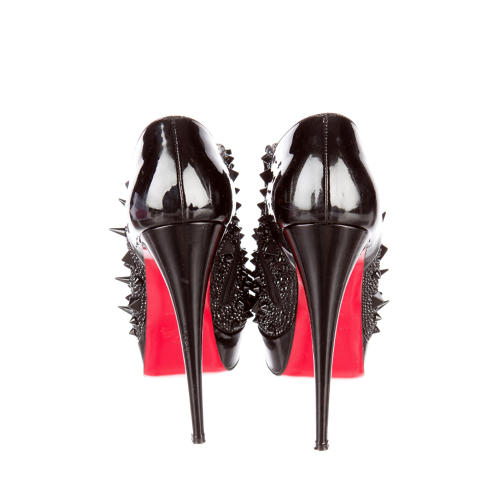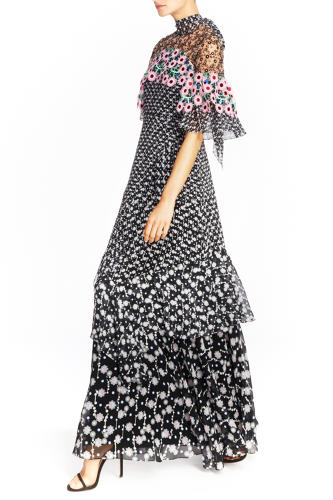High-End Shopping In The Sharing Economy: Now We Can All Have Couture
The Kardashians don’t exemplify thriftiness, so it was surprising when Khloé, Kendall, and Kylie partnered with the luxury consignment site The RealReal in August. The sisters listed 200 pieces from their personal closets, ranging from Chanel purses to Christian Louboutin heels, at nearly 80% off retail value. “Now you can own pieces from my closet!” Khloé Kardashian proudly tweeted to her 21 million followers.
The entire collection sold out within 24 hours, a rep for The RealReal confirmed.
The reality TV stars’ participation confirmed the site as a destination for all incomes and demographics, including celebrities. Today, luxury rental e-retailers, consignment shops, and loan services are destigmatizing what was once considered the domain of aspirational shoppers. More than that, it’s democratizing high fashion and shifting how we buy (and keep) designer clothing.
Even Disney Stars Wear Designer
The constant influx of celebrity news, celebrity stylists, and brand participation on social media means we know everyone’s fashion tastes. Whereas previous generations may have only been familiar with a few design houses—Chanel, Oscar de la Renta, Yves Saint Laurent, for instance—today’s woman is familiar with dozens more, ranging from big (Balmain, thanks to Kim Kardashian) to emerging (Jason Wu, thanks to the Michelle Obama).
Many women once dreamed of emulating Elizabeth Taylor’s wardrobe—and it remained just that: a dream. But today, a savvy shopper could potentially wear whatever Julia Roberts donned for the Oscars. The shopper might only rent the gown for a night, but the Cinderella moment is no longer a fairy-tale fantasy.
“Luxury is changing—and changing for the more value-centric consumers who are much greater in number than pure luxury [products],” says Marshal Cohen, chief industry analyst of the market research company The NPD Group.
“Something that used to be attainable purely for the elite is now becoming more accessible to those who are willing to splurge,” says style expert Jacqui Stafford. “It’s still a splurge, there’s no question about it. You’re still going to be spending at least $500 [to rent] a gown that you might have to pay $5,000 to buy.”
It’s not just Oscar winners who inspire the masses. Teen stars also employ celebrity stylists who deck them in Preen and Vetements. “These labels are definitely more accessible now, and we have social media to thank for that,” Stafford says. “Even Disney stars are sitting front row at Paris Fashion Week shows. You’re seeing the younger demographic really embrace couture, bringing it to a new audience.”
That means a growing percentage of teens and millennials now look way beyond what’s available at the neighborhood mall. They want Gucci, Cartier, and Chanel and they’re getting savvier when it comes to acquiring those marquee designer brands. They are not a demographic to ignore: According to a recent study, millennials spend $200 billion annually and are set to outspend baby boomers by 2017.
Many of The RealReal’s customers are millennials with strong brand loyalty. And they tend to adhere to a specific strategy. They start as first-time buyers, enjoying their discounted designer item until they eventually tire of it and resell it. They then take the money earned to the primary market—to, say, Neiman Marcus, where they buy a new high-end item. Once it’s been seen enough times by their social group, they sell it in the consignment space. Then the process repeats itself. In a way, they’re learning about investment, depreciation, and retaining value, but in the context of designer fashion.
“They’re saving their money for that special Celine bag, and when they’re done with it, they’re consigning it,” says Rati Sahi, chief merchant for The RealReal. “You see them think differently about their purchases. They’re calculating [whether] they can get 60% back with the resale value.”
They’re willing to pay, up to a point. “Millennials are interested in high fashion but not willing to pay those high prices,” Cohen says. “So discount sites, secondhand sites, and stores, as well as auction sites, do well for the luxe millennial.”
If Selena Gomez’s fans are wearing Chanel in greater numbers, how does that affect the label’s mystique? “Ease of access to luxe helps, but also hurts,” Cohen says. “The luxe market is also so accessible it loses some of the panache.”
Style Gone Social
Former interior designer Sallie Giordano was surrounded by professional women in New York City who complained of the increasing cost of maintaining their wardrobes. They had full social calendars: speaking engagements, conferences, galas. With designer retailer sales so frequent, consumers “felt stupid” if they purchased full price, Giordano says.
In April 2015, Giordano launched Couture Collective, a luxury clothing rental membership club. It’s like a “timeshare” of seasonal designer apparel. Members pay an annual fee of $250, then each season, they can borrow up to five dresses from, say, Valentino and Christian Dior, after they’ve purchased a one-fifth share in an item, at 20% of the retail price. “If you look at the statistics, people will wear a dress three or four times and then they consider it an old dress,” says Giordano, who says she sees lots of women who will only wear current season styles.
Couture Collective’s clientele ranges from wealthy women to upper-middle-class aspirational shoppers, all looking to showcase a well-kept designer closet.
“I think the average person is interested in wearing these [designer] styles because honestly, they’re better styles,” Giordano says, noting how high-end garments are well made with quality fabrics and flattering cuts. “When you wear these dresses, there’s a huge difference. You just feel special and confident.”
For Couture Collective’s clientele, there’s an appealing ease to the idea of renting: No need to store or care for items they intend to wear once. “It’s not about ownership anymore,” Giordano says. “It’s about being able to do something without all the responsibilities of ownership … This allows them to wear the trends of the designers and not feel ridiculous then they’re sitting unworn in their closet the next season.”
Social media has certainly changed the amount of times we wear an article of clothing. Couture Collective’s clients don’t want to repeat an outfit, especially if their event is photographed for publication on Instagram or Facebook.
The Instagramming of outfits was a consideration for Armarium, an on-demand luxury rental site that launched in November 2015. It is a true high-fashion lover’s dream, featuring selections from the top design houses as well as emerging international labels. While the options on Rent the Runway can feel a bit sartorially safe, Armarium caters to those looking to get noticed in fashion-forward garments. Some offerings are exclusive to Armarium, which directly negotiates with fashion houses.
“Social media has drastically changed the game of how we access products, particularly with statement pieces,” Armarium cofounder and CEO Trisha Gregory says. Her business works in tandem with retail and e-commerce, with the goal of serving as a complement to full-price investment staples like black pants or a white shirt. Armarium partnered with Net-a-Porter to assist customers in putting together an ensemble that’s part rented, part purchased. For example, you can rent a statement Sonia Rykiel tunic from Armarium, then link out to Net-a-Porter to finish the look with a splurge trouser or investment stiletto.
“This is a smart way to complement [a customer’s] existing wardrobe and the pieces she will buy for the season,” says Gregory, whose clientele is made up primarily of women aged 28-34. Helping customers discover new items is a big aspect of the service; the full range of offerings are visible on the site and there are also showrooms with experienced stylists on hand. “We want to give them access to shopping in an innovative way,” Gregory says.
Armarium sees two types of renters. The first is the busy, high-net-worth individual who values convenience. She’s on the move, attending multiple conferences or vacationing in St. Barts. “We’re packing her bags and getting her out the door, easing her schedule,” Gregory says. “We’re seeing the stigma [around renting] debunked with what the high-net-worth individual thought about the concept of renting…. For them, this is about access to statement pieces that aren’t in the market most times.”
Then there’s what they call the “HENRY,” the high-earner-but-not-rich-yet aspirational shopper. She’s social media-savvy and cares about brand identity. In Gregory’s words, it’s “very hard” for her to re-wear pieces. Both types are return customers, on average 28% of the time. Business is booming: Sales have tripled since Armarium launched its mobile app in April, with a 40% month-over-month growth of app downloads and site visits.
“Women are starting to shop in a different way,” Gregory says. “People want an experience, and that’s what we strive to give them. This is basically a celebrity offering.”
Less Is Now More
One thing celebrities have easy access to that the average woman does not: bling.
Flont is a jewelry loan service set to launch this fall. It plans to do for bling what Couture Collective does for fashion. Flont lets customers borrow a certain amount of designer jewelry at different membership rates. For $199 a month, you get $60,000 worth of jewelry a year. Up your monthly fee to $1,999 and you’re entitled to $100,000 worth of jewelry over 12 months. Designers include red carpet favorites like Irene Neuwirth and Paige Novick.
But why would the well-to-do woman rent when she could buy? Flont’s founder Cormac Kinney points to the private-jet industry as a comparison.
“Certainly, if you can afford a NetJets membership, you can afford a jet—but that’s not the point. The point is convenience,” he says. “It’s much more convenient to let someone maintain it and you just use it when you need it.”
The company commissioned a survey sampling U.S. women with a minimum household income of $65,000 who had purchased $2,000 or more in fine 18K gold jewelry in the last 12 months. They found that 88% said they would buy a piece they loved even if it was worn by someone else before, and 75% were interested in jewelry sharing.
Many don’t want the complications that come with owning burglar-bait. Jewelry insurance, for example, adds an extra layer of cost, which can run over $10,000 a year. With Flont, insurance is included.
Then there are those who, inspired by the cult decluttering bible The Life-Changing Magic of Tidying Up, simply want less stuff. Excess is no longer chic.
“A lot of young women out there think, ‘I want to have a great dress and great piece of jewelry and I’m willing to spend a few hundred dollars but I don’t want to own it,’” says Milton Pedraza, CEO of the consulting firm Luxury Institute. On the other end, baby boomers now see an alternative to constant consumption: “Many older women want to declutter their closets. They don’t want to be wasteful.”
This mentality inspired VillageLuxe, a community-based fashion borrowing site that connects women’s closets. It extends the age-old “can I borrow that?” philosophy across entire neighborhoods, like an Airbnb for fashion.
“There’s this sense of wastefulness and this big gap between my ability to wear more than three pieces at a time out of my 300 pieces,” says Julia Gudish Krieger, founder and CEO of VillageLuxe. “The [designer rental market] is focused on that aspirational consumer, but I think you polarize and leave out a whole big part of the market of people who don’t need the money—it’s just the sense of wastefulness.”
Krieger launched the site in July 2015 after asking herself, Which of my assets that I don’t use every single day would people want to rent? “After my house and my car, it’s my closet,” she says. (Though, in New York, one’s closet might actually top that list.)
“I’m such a believer in the sharing economy,” says Krieger, a former VC. “I think it’s where the world is heading in general, and it’s not just that people are becoming more efficient with how they monetize things when they’re not using them. The more interesting element is the social barriers between what’s mine and what’s yours have blended so much more in the last five years.”
Village Luxe is currently invite only, with a heavy emphasis on influencers and fashionistas who lend as well as borrow. As of August, more than 10,000 women were on the wait list. Current members are quite active, having already listed over 7,000 pieces. (VillageLuxe intends to open the list once they’ve scaled the company.) For the moment, members include Upper East Side wives with extensive jewelry collections and edgy fashion bloggers like Leandra Medine, i.e.,The Man Repeller.
The startup emphasizes vintage styles as well as current collections. Many of their clothes are garments you can’t find anywhere else, like an Alaïa cocktail dress from the ’90s. “We actually had Vogue start borrowing from us for editorials,” Krieger says.
Investing 101
Like The RealReal, Village Luxe is watching customer habits shift in real time.
“Once [our members] find out that VillageLuxe exists, they buy fewer but much more expensive pieces—statement pieces—because you know you can pull value out of them between wears,” Krieger says. “Then you won’t feel bad about that McQueen blazer that you really had your eye on, which you can physically only wear once a month with different groups of people.” This buy-and-share mentality, Krieger hopes, will motivate shoppers to make smarter decisions.
These sites can also alter the calculus of hemming and hawing over a pricey outfit. A customer is more likely to swipe their credit card if they know they can make some of their money back. “Women list things as soon as they buy them—they’ll list the items sometimes before it’s even arrived.”
Krieger says that aspirational shoppers especially are changing their strategies. They’re more likely to go for a few select designer items than whatever is on the shelf at H&M or Zara. They see it will actually pay for itself and even create a revenue stream. “They can justify going higher market,” she said.
A high overlap exists between the renters and the lenders, with over 40% who lend using their earnings as credit to borrow. “There’s circuitry in the market,” Krieger says. Women now think one step ahead when it comes to their wardrobe, debating what’s worth what and where to put their next dollar.
It’s a whole new way of shopping—and experts don’t see the trend waning. As Giordano says, “Once you start wearing designer, it’s really hard to go back.”







Fast Company , Read Full Story
(20)













